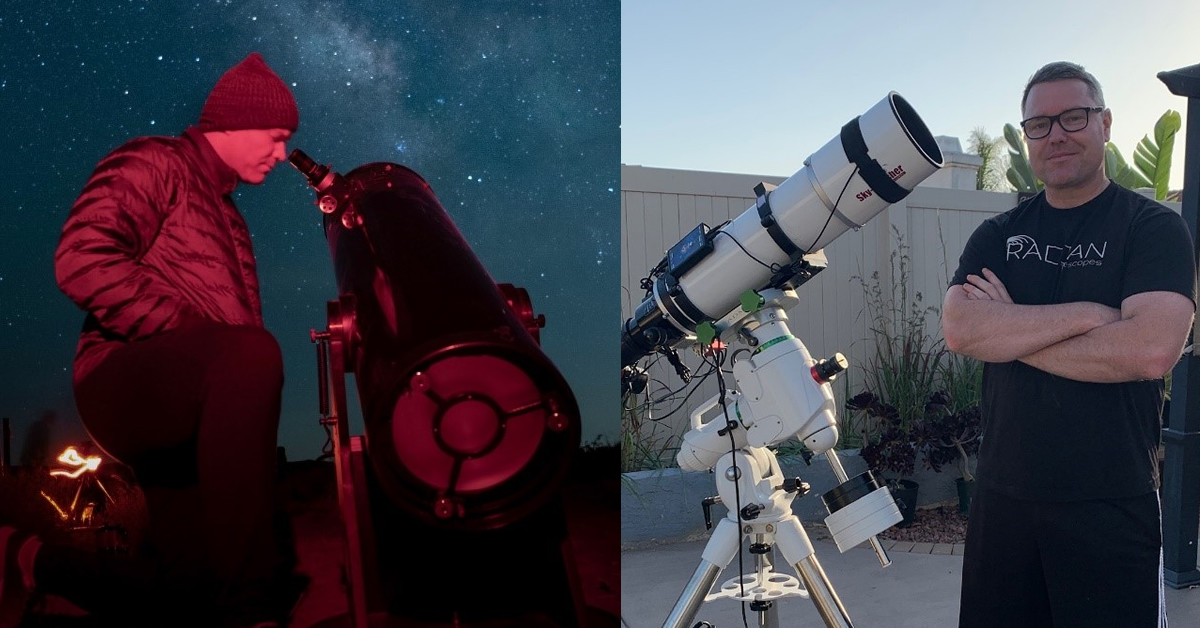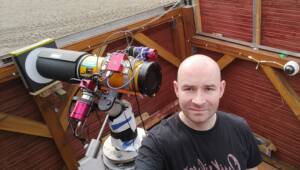Q1: At first, congratulation that your nice image won #ASIWEEK. Can you introduce yourself to us?
Hi! thank you so much for the honor and selection of my image for ASIWEEK. My name is Charles Bonafilia, I’m located in sunny San Diego, Ca and image from my backyard predominately. My current job allows me the opportunity to be in Bortle 1 skies; unfortunately, I’m unable to image due to all the rocking and rolling while at sea. I’m happily married and have 3 wonderful children.

Q2: Why do you love astronomy? What had brought you the passion for astrophotography?
Photography has always been a passion of mine, I’ve done quite a bit of family portraiture and landscapes. Landscapes, is where my journey began in to astrophotography, first with Milky Ways and progressing to deep sky imaging. The progression was quite sudden for me; I used the environment of being alone and focusing on one aspect to help cope with my diagnosed mental health issues. It provided an escape for me; it allowed me to focus my thoughts and calm my mind. In essence, it’s been a life saver for me literally. I’ve been imaging now for a little over a year and I continue to be in amazed by what is unseen by everyone else. Going out in night sky, looking up and being able to see all the colors and picturesque skyscape that only a few people know about expresses to me that there is so much more to life in general and I want everyone to have the same experiences that I do. Being able to involve my family is a huge benefit of this hobby. It gets us all out of the house and in to nature; it gives us more bonding time as a family.

Eagle Rock, Warner Springs Ca. With my Son holding a lantern
Q3: What gear do you use? Would you like to show us some pictures of them?
I went through the dreaded buying gear phase of astrophotography, starting with the WO Spacecat and the ASI1600MM Pro, within 2 months I had already outgrown what I thought were the capabilities and wanted different means of producing the images I do. All my gear is ZWO, from the filter wheel, focuser and the cameras. I own the ASI533MC Pro, ASI294MM Pro, ASI174MM, ASI120MM and the ASI290MM and I finally settled on the ASI6200MM Pro. I can’t say enough amazing things about this camera it’s a workhorse and provides everything I’m looking for, small pixels, large well depth and 16-Bit capability. My main scope currently is the Sky-Watcher Esprit 120ED mounted atop the Sky-Watcher EQ6r Pro. All of this is powered through and managed with the ASIAIR PRO. I look forward to pairing my ASI294MM Pro with a newer scope so watch for those images coming soon.

Q4: Your winning picture the Horsehead Nebula is so stunning, It is one of the most beautiful pictures we’ve seen for this target! How did you capture it?
Thank you, the Horsehead Nebula was a labor of love; I initially had the thought of imaging this target in the false color (SHO) and had 24 hours of Ha (Hyrdogen Alpha) data but after researching through imagers that processed it that way…it just didn’t stand out to me. So, I jumped on to my IG page and polled what people wanted to see, it was overwhelmingly for true color (RGB). I finished the image out with over 6 hours of each bandwidth imaging from my backyard (bortle 6)

Horsehead/Flame Nebula + ASI6200MM Pro + Skywatcher EQ6r Pro + Bortle 6, imaged in HaRGB
Q5: And how did you do the post-processing, is there any skills you can share with us?
Post-processing for me is pretty cut and dry. Prior to combining all the channels I develop a mental picture of what I want the final image to look like. From there it’s just peeling the layers back until I achieve the result I want. Stars seem to be a big issue, especially when imaging the Horsehead, imagers have to deal with Altinak. Other than having high quality filters to help prevent halos, I also process my image separate of stars and recombine them as a luminosity layer within photoshop.

California Nebula + ASI6200MM Pro + Skywatcher EQ6r Pro + Bortle 6, imaged in SHO
Q6: People say post-processing is one of the most difficult parts of AP, how do you think about it?
I originally had a similar thought process, but like everything you do; it gets easier the more you do it. If you’re limiting yourself to only platform for processing then you’re limiting your creatively. If you’re comfortable using photoshop then use photoshop. The issues come up when the results are not what the imager wanted or thought they should look like. When that happens switch platforms and try something new. Pixinsight does great with background extractions, star mask and color mask, so do the technical processing in Pixinsight and the creative work in photoshop, lightroom or your specific platform you’re comfortable with; biggest thing is, don’t limit yourself.

Rosette Nebula + ASI1600MM Pro + SkyWatcher EQ6r Pro + First use with Pixinsight

Rosette Nebula + ASI6200MM Pro + SkyWatcher EQ6r Pro + continued use with Pixinsight
Q7: Where do you normally take your astrophotos? Do you have a private dome or observatory?
Most of my photos are taken right from my backyard; the capabilities that are available to the consumer/hobbyist allow each of us to remain closer to home vice having to carry out all our equipment to secluded Bortle 2-3 areas. While I do venture out there for star parties, I’m comfortable sitting on the couch with my family while my imaging rig does its thing. Having a private dome/observatory is definitely in my future at some point. I just need to find the time to build one and set it all up.

Q8: Do you have any unforgettable experience during these years of astrophotography?
Being still fairly new to astrophotography (1.5 years), my most memorable time to date is still going to my first star party. While it was limited in size due to restrictions in place because of the pandemic. It was fantastic to see the like-mind people that carried the same passion as I had. It made me feel like I was a part of something bigger, a movement that is happening all around the globe right now in expanding one thoughts of Earth being so small in the full realization of the universe and trying to increase our understanding the void that we call space. It’s not so empty and black…

Visual Observation + SkyWatcher 12” Dobsonian + Landers, Ca (Bortle 3)
Q9: What kind of targets is your favorite for shooting?
I feel this is like asking if you have a favorite child! Nebulas are image du jour at the moment. They offer so many different colors ranges within the nebulosity. I use the natural highlights and shadows to my advantage. Although, galaxies continue to amaze me. I’ll definitely shoot more of them once I get a bigger telescope. I’m all about the details.

Jellyfish Nebula + ASI6200MM Pro + Skywatcher EQ6r Pro + Bortle 6, imaged in SHO
Q10: Do you think astrophotography has changed you over these years?
Definitely, I don’t look at the night sky the same anymore and I look at my own inner turmoil’s and see the really don’t matter in the grand scheme of things. I’ve learned to relax and take everything in around me; from the smells and sounds outside to finally seeing all the beauty the night sky has to offer.

Milky Way over Bonsai Rock, South Lake Tahoe, NV
Q11: Are you active in other astronomy-related activities except from astrophotography?
I am. I still enjoy going out and imaging the milky-way whenever I get a chance, it’ll remain a passion. I’ve also been doing more visual astronomy; trying to get my family and community more involved.

Milky way over Ladera Street beach access, Point Loma, Ca
Q12: When and how did you know ZWO? What was your first ASI camera?
My first ZWO was a used 1600mm Pro and it performed absolutely fantastic! I’ve never used any other astro-dedicated camera and I never will. The technology that is coming out with all the new CMOS sensors and ZWO at the forefront there is no reason to ever change. Everything I need is wrapped in an all-in-one red package.

First ever image using the ASI1600mm Pro, Trifid Nebula in LRGB (Bortle 6)
Q13: Do you like your ASI6200MM Pro the full frame camera?
I can’t say enough good things about this camera!! I went with the full-frame specifically for its 16 bit capability. Shooting objects thousands of light years away they tend to have a flat appearance and with the 16 bit capability I’m able to bring out variations in lights/shadows that lend to a better 3D effect. Nothing on the market compares!

Christmas Tree and Cone Nebula + ASI6200MM Pro + EQ6r Pro + 54 hrs integration (SHO)
Q14: We see you have an ASIAIR PRO for control. Does ASIAIR PRO truly make your astrophotography project easier and more interesting?
The ASIAIR simplifies everything I need to produce the images I do. All the features available make it a one stop shop for me. I’ve used other programs and the versatility/portability (via my iPad) is second to none. I’ll be using both of my ASIAIR Pros for as long as I’m imaging. The easy of use and setup for each image within the ASIAIR App couldn’t be easier. The biggest aspect I enjoy about the ASIAIR is the regular tech refresh. ZWO adds new features constantly and listens to the feedback of its consumers. You don’t find that a lot.

ASIAIR PRO adapted to Skywatcher Finder scope bracket
Q15: One last question: Do you have any suggestions for us? Where do you think we can improve?
This is a tough question. Customer support is excellent, product support is excellent. Is there anyway to branch out and have an office/distribution center in North America? Otherwise keep doing what you are doing. For app support, my only request would be to have the ability to select the same guide star after an auto-focus routine is complete. The guide star that I choose is typically the better star, based on size and brightness. When the focus routine completes the software choose the best star based on the programmatic software coding. This is not always the best…typically I stop the image and guiding to reselect my original star. Coding would be simple it the fact that it is a if/then statement.




















